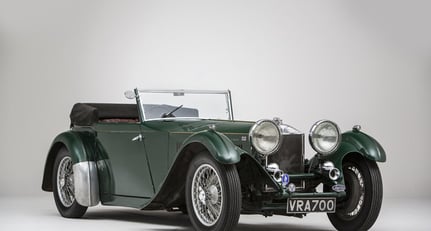1930 Invicta 4 1/2 Litre
-
Year of manufacture1930
-
Chassis numberS106
-
Engine number7408
-
Lot number341
-
DriveLHD
-
ConditionUsed
-
Number of seats2
-
Location

-
Exterior colourOther
-
Drivetrain2wd
-
Fuel typePetrol
Description
1930 Invicta 4½-Litre S-Type Low-chassis Drophead Coupé 'Salamander'
Coachwork by Corsica
Registration no. VRA 700
Chassis no. S106
Engine no. 7408
'The low chassis Invicta was probably the best-looking sports car in the vintage tradition ever to be produced in England. I can think of no contemporary unsupercharged motor-car of similar capacity, made here, which could outperform it - and very few built elsewhere...' J R Buckley, 'The 4½-litre S-Type Invicta', Profile publications, 1966.
In an era when most cars stood tall, Invicta's 4½-litre S-Type, with its dramatically under-slung chassis, caused a sensation: few sports cars before or since have so looked the part. The origins of the company known as Invicta Cars go back to 1925 when Noel Macklin and Oliver Lyle, both of whom already had motor industry experience, got together to create a car combining American levels of flexibility and performance with European quality and roadholding. Like the contemporary Bentley, the Invicta was designed by men with backgrounds in competition motoring and both were produced to the highest standard. Price was only a secondary consideration, a factor that contributed to both firms' failure to survive the Depression years of the early 1930s. Like Bentley, Invicta struggled against rising costs and falling sales, the final car leaving the factory, appropriately enough, on Friday the 13th of October 1933, though a handful of cars was assembled at the company's service depot in Flood Street, Chelsea between 1934 and 1936. It is estimated that approximately 1,000-or-so Invictas of all types were made.
Launched at the 1930 Olympia Motor Show, the S-type's 'under-slung' chassis achieved a much lower centre of gravity by positioning the axles above the frame rails instead of below as was normal practice at the time. Just about the only thing the S-type Invicta had in common with its contemporary stablemates was the 4½-litre Meadows engine, which was also used for the 'NLC' and 'A' models.
The popular '100mph Invicta' tag notwithstanding, standard cars had a still impressive top speed of around 95mph, with more to come in racing trim. However, it must be stressed that the S-type Invicta was primarily a very fast but comfortable high-speed touring car, and though it met with moderate success in racing in the hands of private owners in the early 1930s, its greatest appeal lies in an ability to cover big mileages at high average speeds with no strain, either to driver or the machinery. Raymond Mays, writing of the two Invictas he owned in the early 1930s, says that they gave him some of the most exhilarating motoring he ever had, with their ability 'to crest most main-road hills at nearly the century.'
Invictas are about as indestructible in normal use as a car can be. Over 70 years after the last was built, approximately 68 of the estimated 75 S-types built are known to survive and most are in excellent order, testifying to the fact that they have always been regarded as high quality motor cars. Indeed, in pre-war days there was a club dedicated exclusively to the model and members famously christened individual cars with names like 'Scythe', 'Scrapper' and 'Sea Lion'.
First registered on 11th December 1930, this Invicta S-type, chassis number 'S106', has been in the current family ownership since 1983 when it was purchased by the vendor's father, who bestowed on it the nickname 'Salamander'. The Invicta joined a distinguished stable that already included a Lagonda V12 and Healey Abbott. Ownership passed to the vendor in 2005 but his father continued to maintain the car until his death in 2007. The vendor's father undertook a lot of research to trace the car's history, and the document files include correspondence over many years with former owners. He used the Invicta enthusiastically, attending numerous touring rallies in the UK and Europe, including Paris-Deauville and the Rallye du val de Loire, and used it to drive his daughter to her wedding.
Apparently, Corsica only bodied two S-Type Invictas. This particular car is the only one in this style and carries arguably the prettiest bodywork of any Invicta: low-sluing and sleek, just like a salamander. The other Corsica body was similar to the more numerous Carbodies touring coachwork. Duncan MacGregor, the Invicta club archivist, recently uncovered images of this car on delivery plates at Brooklands in 1930, when it would have been the sixth made. The car appears little changed since.
The Invicta's UK registration history is not known prior to 1950 when it was registered as 'LXC 810'. The known ownership history is as follows: Mrs H P Greenhough, USA (1965-1973); P Faschenmacher (1973-1974); Lothar Frank, Bad Rothenfelde Museum, Germany (1974-1975); Micheal Rochet, Switzerland (1975); Sir John Stewart Clarke, a British diplomat who kept the car in France (1976-1983); Jeremy Wade, who purchased the car at auction (1983); and then the current vendor's father. From 1976 to 1983 it carried 'SC 76' (Sir John Stewart Clarke's private plate) followed by (briefly) 'MNM 336G' and now 'VRA 700'.
Little used in the last five years, the car is in generally good condition, retaining its original chassis, body, engine and gearbox. Following a big-end failure in 1985, the engine was treated to a complete overhaul that included new pistons, re-sleeved bores, reground crankshaft, new clutch, etc. There are bills on file from Vintage Coachworks (Peter Whenman) dating from 1980 to the 1990s (engine work) and others for renovation of the trim and carpets in the 1990s. More recently (November 2011) Meadows engine specialists Bishopgray serviced the car, adjusted the timing chains, fitted a new water pump, flushed the radiator, re-tightened the cylinder head nuts and overhauled the magneto at a cost of £6,000.
A few modifications have been made: a single 12-volt battery has replaced the original set-up of two 6-volt items (supplied with car); flashing indicators have been added; and a cleverly concealed electric cooling fan installed. There is no Autovac, cold-start device or starting jet, while the original Rotax starter and water pump are supplied loose.
A quantity of spares is included in the sale together with previous numberplates; the vendor's father's travelling tool and spares manuals; and the important special tool for the rear brake drums. A large history file is available also, containing a substantial quantity of Invicta-related information, technical drawings and magazine articles, and old-style green logbook, a current V5C and MOT to August 2014.
The engine runs sweetly with healthy oil pressure and well-managed coolant temperature, while the gearbox engages all gears correctly and the car drives and stops well. Salamander is ready to be enjoyed as she is or would make a sound basis for a show-stopping entry at the best concours events. She is a delight to drive and a truly unique version of this important pre-war British sports car.
The 'Low Chassis' Invicta S-Type is now regarded as one of the most desirable pre-war sports cars, sought after by collectors for its exceptional driving abilities, style and sheer presence. A guaranteed entry at the most prestigious rallies, concours and race meetings around the world, the 'Low Chassis' has an enviable reputation amongst connoisseurs and examples are to be found in some of the most important private collections.


























